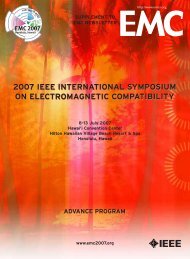Tutorial: EMC & Signal Integrity using SPICE, page 44 - IEEE EMC ...
Tutorial: EMC & Signal Integrity using SPICE, page 44 - IEEE EMC ...
Tutorial: EMC & Signal Integrity using SPICE, page 44 - IEEE EMC ...
Create successful ePaper yourself
Turn your PDF publications into a flip-book with our unique Google optimized e-Paper software.
University of Kentucky where he was a member of<br />
the faculty in the Department of Electrical Engineering<br />
for 27 years retiring in 1998. Since<br />
1998 he has been the Sam Nunn Eminent Professor<br />
of Aerospace Systems Engineering and a Professor<br />
of Electrical and Computer Engineering in<br />
the Department of Electrical and Computer Engineering<br />
at Mercer University in Macon, GA. He<br />
©2010 <strong>IEEE</strong><br />
has published numerous papers on the results of his research in the<br />
Electromagnetic Compatibility (<strong>EMC</strong>) of electronic systems and given<br />
numerous invited presentations. He has also published 16 textbooks<br />
and Chapters in 4 handbooks. Dr. Paul is a Life Fellow of the<br />
Institute of Electrical and Electronics Engineers (<strong>IEEE</strong>) and is an<br />
Honorary Life Member of the <strong>IEEE</strong> <strong>EMC</strong> Society. He was awarded<br />
the <strong>IEEE</strong> Electromagnetics Award in 2005 and the <strong>IEEE</strong> Undergraduate<br />
Teaching Award in 2007.<br />
The GUM Supplement 1 and the Uncertainty<br />
evaluations of eMc Measurements<br />
Carlo F.M. Carobbi, Department of Electronics and Telecommunications Via S. Marta 3,<br />
50139–Firenze, ITALY carlo.carobbi@unifi.it<br />
Abstract—The “Guide to the expression of uncertainty in<br />
measurement” (GUM) provides the theoretical framework<br />
which is worldwide adopted for the evaluation of<br />
measurement uncertainty, including the application to<br />
calibration and testing. The GUM uncertainty approach<br />
has however fundamental limits. If these limits are<br />
exceeded the results produced are no longer valid. The<br />
Supplement 1 to the GUM (GUMS1) describes a numerical<br />
technique aimed at extending the validity of the<br />
uncertainty evaluations to cases where the application of<br />
the GUM does not produce reliable results. The scope<br />
here is to point out the conditions under which it is necessary<br />
to make use of the GUMS1 technique. Explicit<br />
reference to Electromagnetic Compatibility (<strong>EMC</strong>) measurements<br />
will be made.<br />
1. introduction<br />
In 2008 Supplement 1 to the “Guide to the expression of<br />
uncertainty in measurements” (GUM) [1] was published by<br />
the Joint Committee for Guides in Metrology (JCGM). To<br />
the JCGM, which is chaired by the Bureau International<br />
des Poids et Mesures (BIPM), contribute the International<br />
Electrotechnical Commission (IEC), the International Federation<br />
of Clinical Chemistry and Laboratory Medicine<br />
(IFCC), the International Laboratory Accreditation Cooperation<br />
(ILAC), the International Organization for Standardization<br />
(ISO), the International Union of Pure and<br />
Applied Chemistry (IUPAC), the International Union of<br />
Pure and Applied Physics (IUPAP) and the International<br />
Organization of Legal Metrology (OIML). The Supplement<br />
1 to the GUM (GUMS1) was prepared the Working Group<br />
1 of the JCGM, which has the task to promote the use of<br />
the GUM and to prepare Supplements in order to broaden<br />
the range of its applications.<br />
The GUMS1 provides an easy to implement numerical approach<br />
to the evaluation of measurement uncertainty named<br />
“propagation of distributions”. The GUMS1 approach goes beyond<br />
the limits inherent to the GUM theoretical framework,<br />
which is based on the law of propagation of uncertainty and on<br />
the central limit theorem.<br />
The GUMS1 is consistent with the GUM, in that the basic<br />
concepts and the terminology inspiring the guides are nearly<br />
the same. However some subtle, but deep, differences exist, the<br />
main consequence being the absence, in the GUMS1, of the<br />
Welch-Satterthwaite formula and of the concept of effective degrees<br />
of freedom [2, Appendix G].<br />
The scope here is to clearly identify the situations where the<br />
application of the GUM uncertainty approach does not produce<br />
reliable results, and the numerical technique described by the<br />
GUMS1 is therefore needed. The operation of the propagation<br />
of distributions technique is briefly outlined and the few conceptual<br />
modifications introduced by the GUMS1 are also analyzed.<br />
An exemplification is offered through an application to<br />
Electromagnetic Compatibility (<strong>EMC</strong>) tests, in order to show<br />
how an uncertainty budget can be appropriately handled in the<br />
GUMS1 framework.<br />
2. Uncertainty evaluations in the<br />
GUM Theoretical Framework<br />
The theoretical framework of the GUM is based on: a) the law<br />
of propagation of uncertainties (LPU), and b) the central limit<br />
theorem (CLT). In order that an uncertainty evaluation made<br />
according to the procedure described by the GUM may be correct<br />
the assumptions required for the validity of both LPU and<br />
CLT must be satisfied. Let us recall these assumptions starting<br />
from LPU.<br />
2.1 The law of Propagation of Uncertainty<br />
Let<br />
Y 5 f1X 1, X 2, ..., X N 2 (1)<br />
be the mathematical model linking the input quantities<br />
X 1, X 2, ..., X N to the output quantity Y. Y is the quantity<br />
of interest, for which we need to evaluate the best estimate y,<br />
53

















